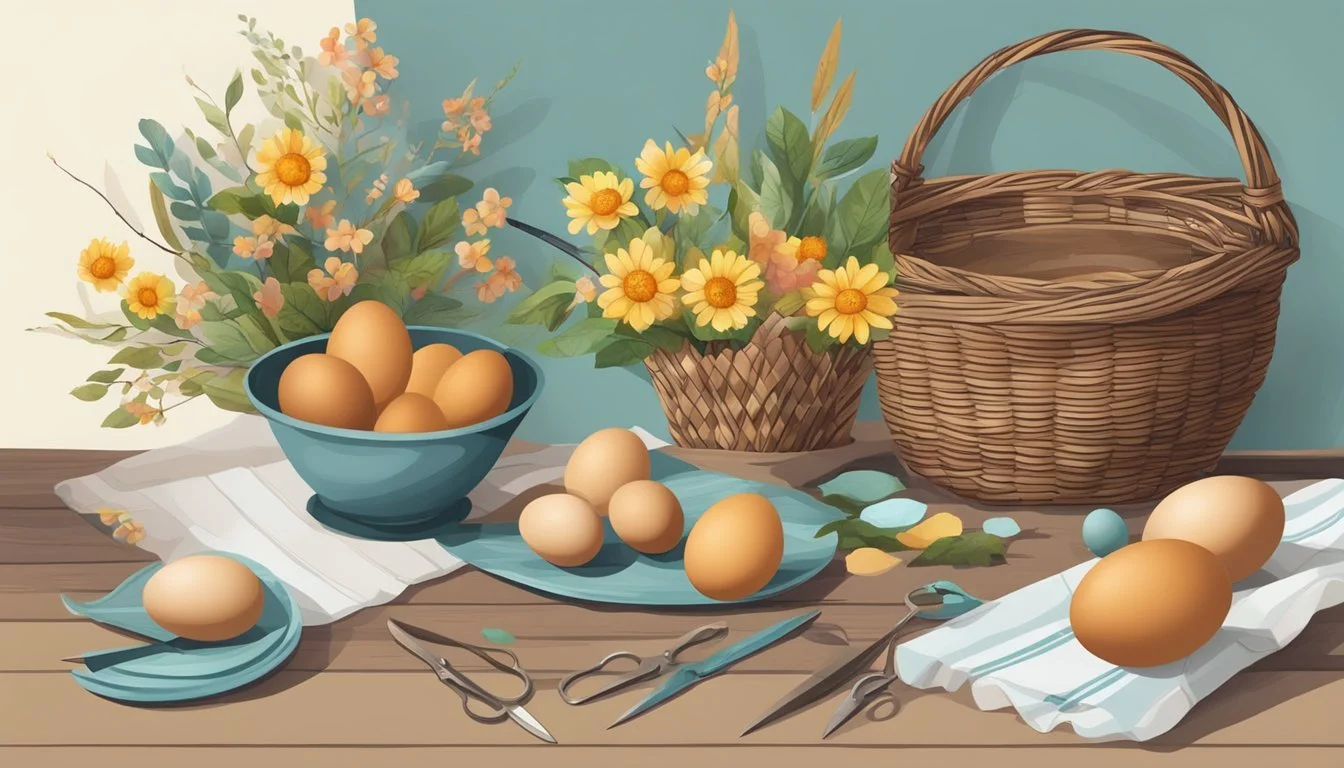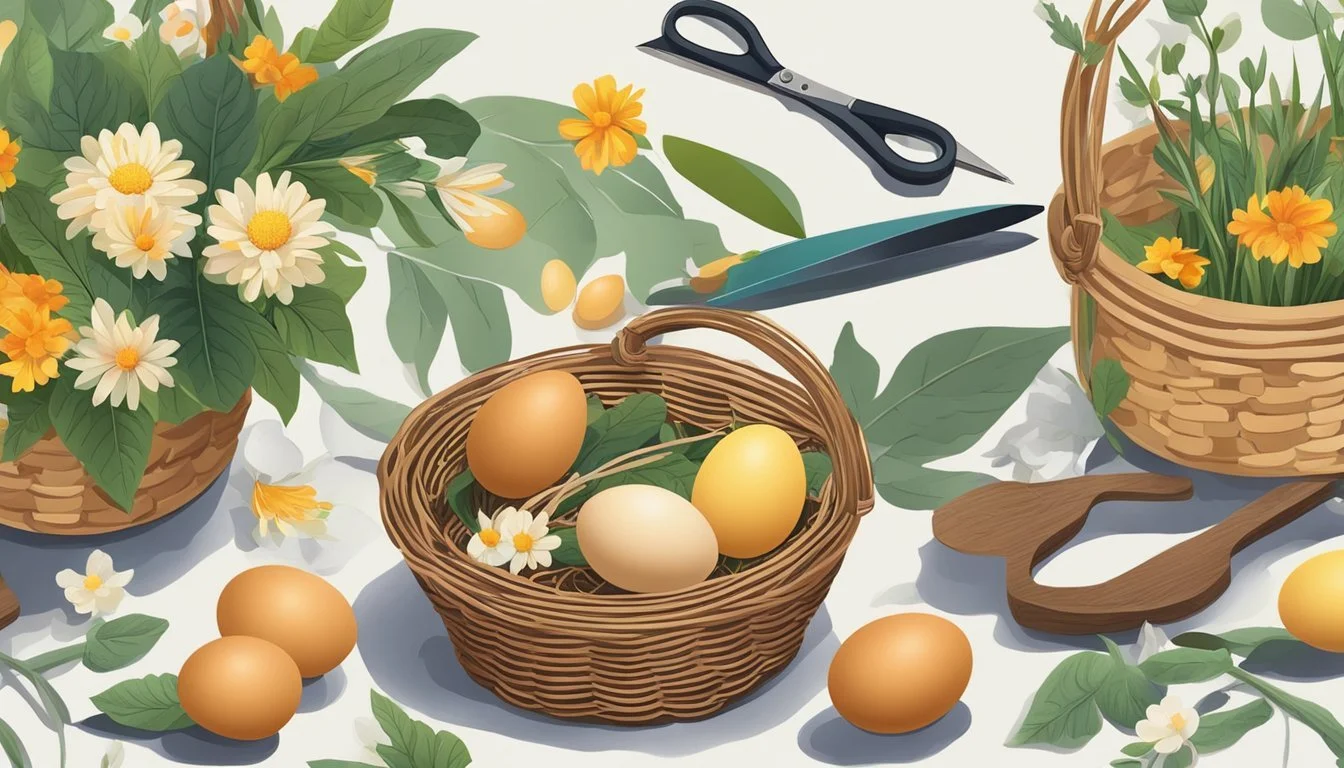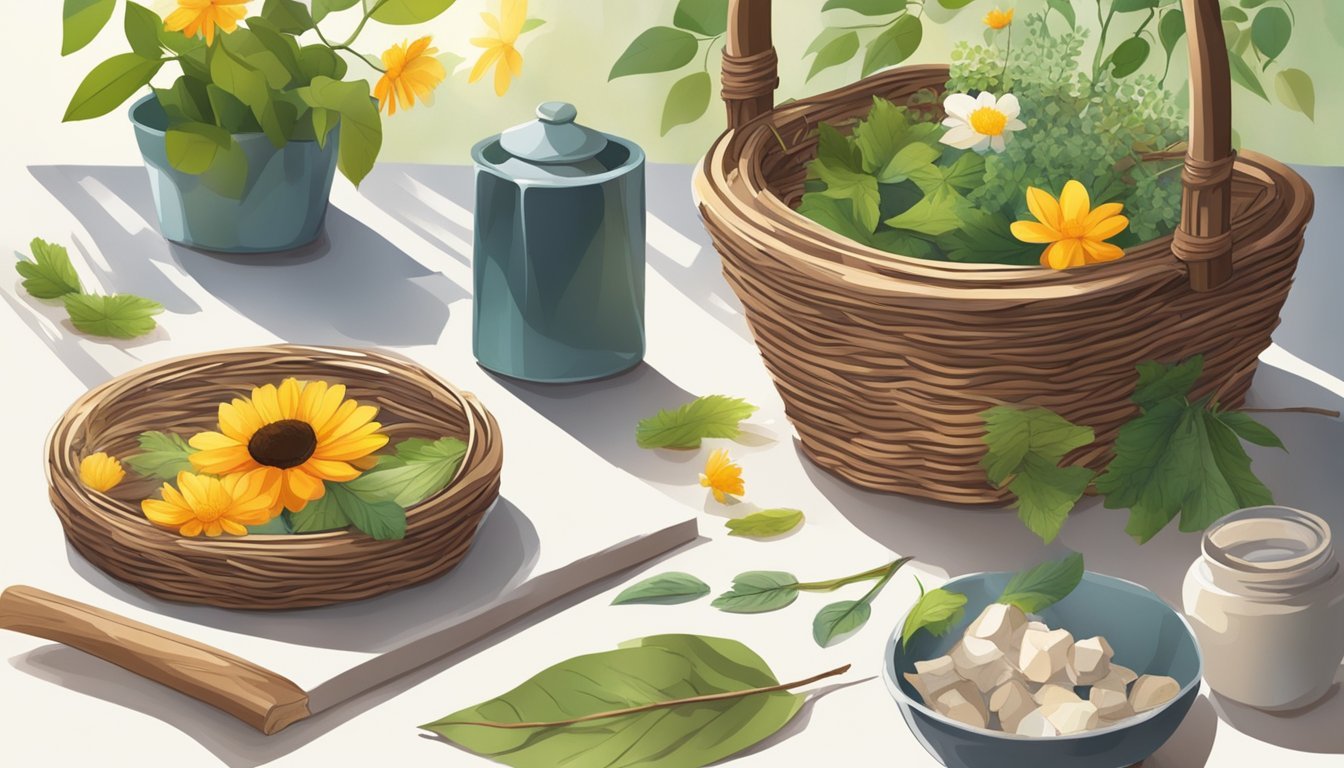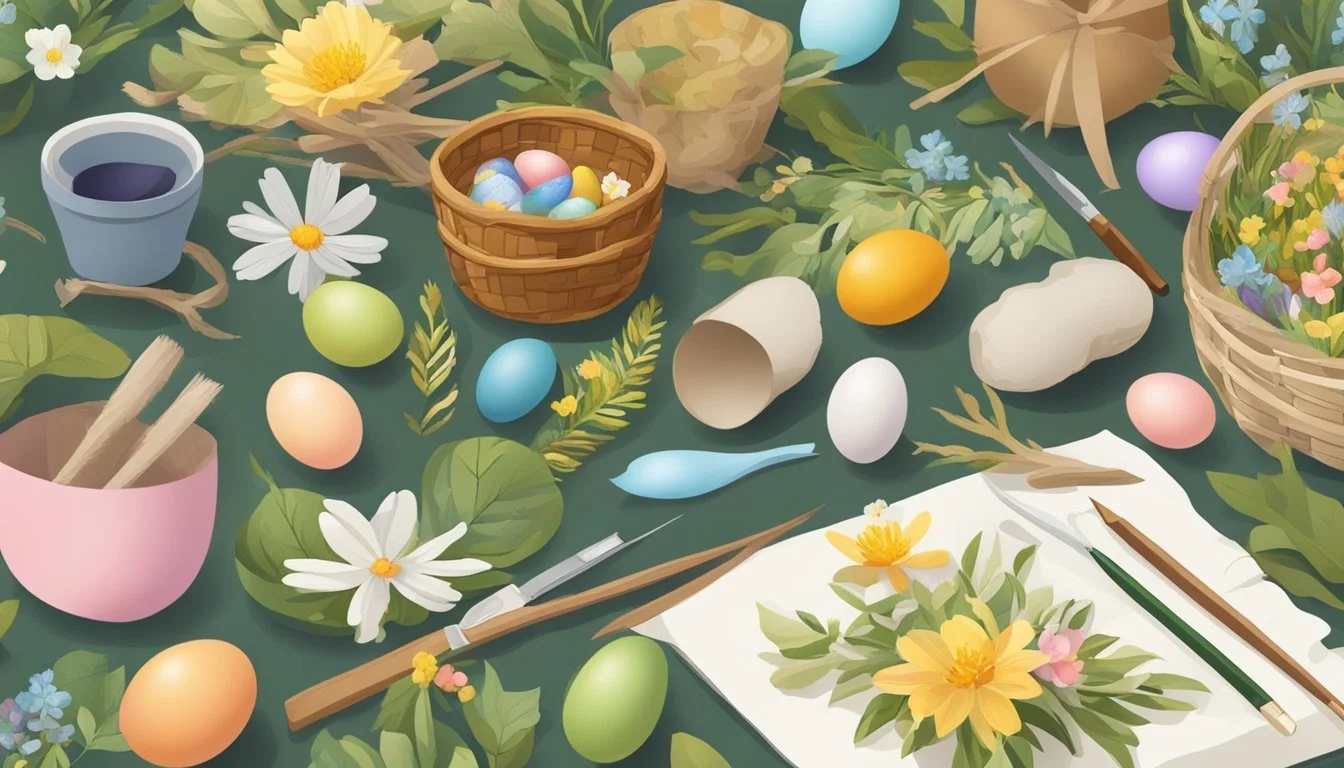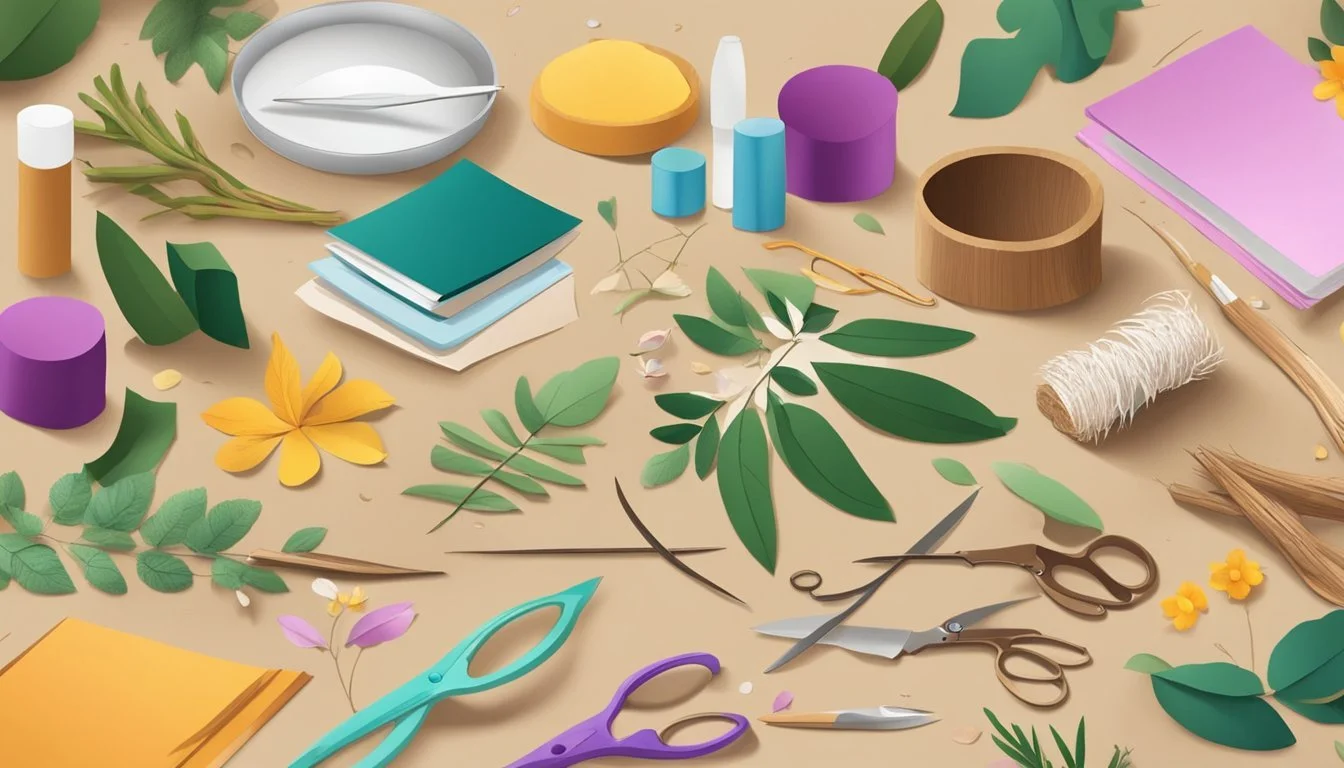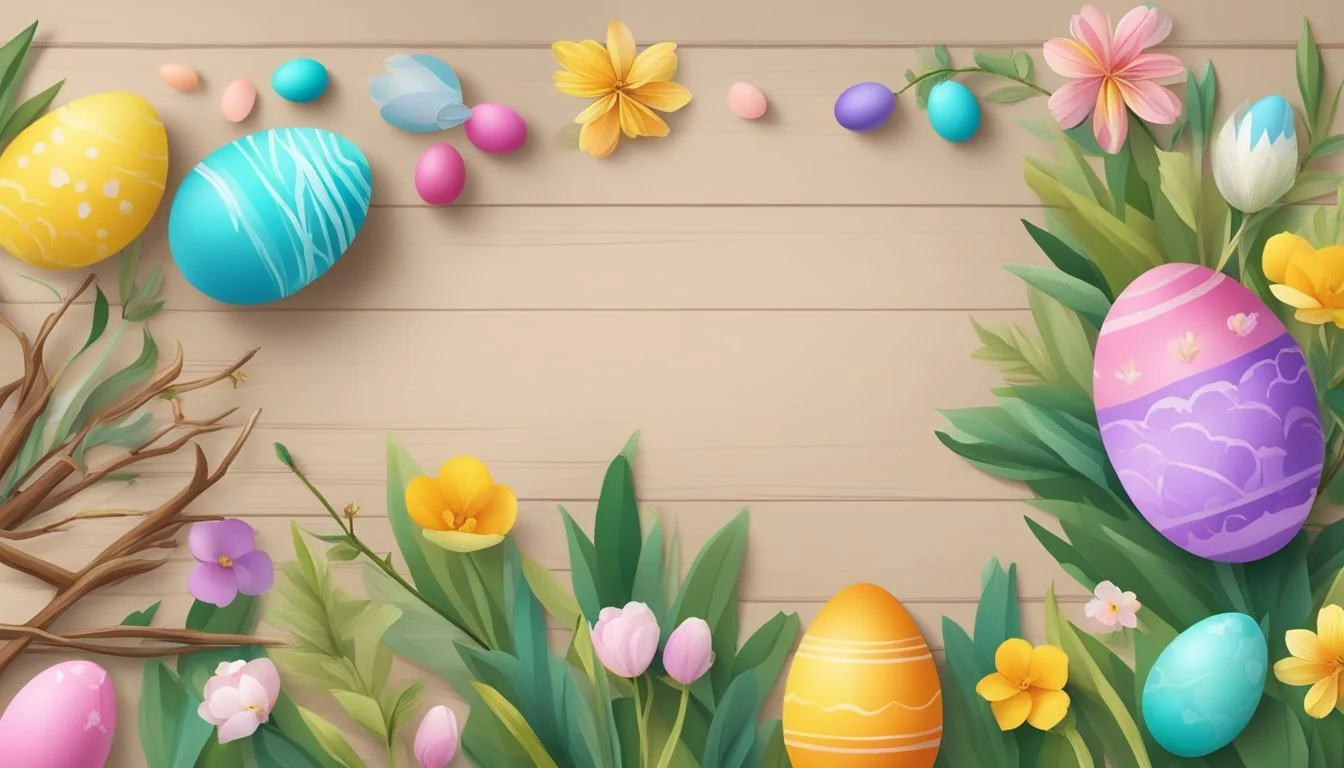Easter Crafts with Natural Materials
Eco-Friendly DIY Projects for the Holiday
Easter marks a joyous occasion that melds cultural and religious traditions, celebrated with various activities that often include crafting. Embracing eco-friendly practices, many seek to incorporate natural materials into their Easter crafts. These crafts resonate with the themes of spring, a season synonymous with growth and renewal, making natural elements particularly fitting.
Crafting with materials sourced from nature not only fosters creativity but also encourages environmental awareness. The use of twigs, leaves, and flowers to create Easter decorations or the repurposing of household items like Mason jars and toilet paper tubes for Easter-themed projects exemplifies sustainable crafting. The versatility of these materials allows for a wide range of crafts suitable for all ages, crafting skill levels, and aesthetic preferences.
Natural Easter crafts can serve as an engaging way to connect with the holiday's significance and the vibrancy of the spring season. Whether the goal is to fashion quaint home decorations or to engage in family-friendly activities, utilizing natural materials provides a unique opportunity to imbue Easter crafts with personal flair while being mindful of the environment.
Understanding the Basics of Easter Crafting
Easter crafts are a vibrant expression of the holiday's spirit and the spring season. They offer a way to bond with family while being mindful of nature by choosing eco-friendly materials.
The Significance of Easter Crafts
Easter crafts not only embody the festive mood of the holiday but also serve as a means for family and friends to engage in creative activities together. For kids, crafting can be educational and entertaining, helping them understand Easter's cultural significance. These crafts often symbolize new life and renewal, aligning with spring's themes of rebirth and nature's awakening.
Choosing Natural Materials for Easter
When selecting materials for Easter crafts, considering eco-friendly options is beneficial for the environment and adds a natural charm to the creations. Natural Materials for crafting may include:
Twigs and Branches: For wreaths or basket handles.
Pine Cones: Can be transformed into birds or decorative pieces.
Rocks: Painted rocks can serve as ornaments or garden markers.
Wool or Cotton Yarn: For creating pom-pom bunnies or garlands.
These materials not only reduce the environmental impact but also bring the textures and colors of nature into Easter decorations, making the celebration more authentic and grounded.
Planning Your Easter Crafts
When planning Easter crafts, one should focus on fostering family participation and choosing sustainable materials to ensure a memorable and eco-friendly experience.
Involving Family Members
Easter crafts provide an excellent opportunity for family bonding. Parents can engage children in activities like painting or decorating Easter eggs, which not only cultivates creativity but also allows each family member to contribute their unique touch to the festivities. For a harmonious crafting session, it is helpful to assign tasks suitable for different age groups. Children can indulge in simpler tasks such as sticking or assembling, while adults can handle more complex steps like cutting or supervising the use of adhesives.
Selecting the Right Tools and Materials
Selecting the right materials is crucial for successful Easter crafts. Environmentally conscious crafters often prefer using natural materials. Here's a quick guide to help them choose:
Material Use Natural dyes For egg decorating Recycled paper For constructing Easter baskets or egg wrappings Wooden decorations As eco-friendly decor Wool felt For crafting felt Easter eggs
Crafters should also ensure they have the correct tools on hand, such as scissors, natural fiber yarns, and eco-friendly glues, to make crafting seamless and enjoyable. The tools should be safe for all family members to use, with age-appropriate items set aside for kids to encourage their participation while ensuring their safety.
Creative Easter Crafts Using Natural Materials
The allure of Easter crafts lies in the harmonious blend of tradition and nature. Embracing eco-friendly materials not only enhances the festive spirit but also fosters a sense of environmental responsibility.
Decorative Easter Eggs with Natural Dyes
One can achieve a spectrum of vibrant hues on their Easter eggs using dyes derived from natural materials. Beets provide a deep red, turmeric offers a bright yellow, while blueberries create a subtle blue. For a rustic feel, individuals can wrap the eggs with onion skins before boiling to imprint intricate patterns.
Ingredients for Natural Dyes:
Red: Beets, cranberries
Yellow: Turmeric, chamomile tea
Blue: Blueberries, red cabbage
Green: Spinach
Orange: Onion skins, paprika
Dyeing Process:
Boil the natural ingredients in water to extract color.
Add a teaspoon of vinegar to the dye to help the color set.
Place the eggs in the dye for varying times for different shades.
Nature-Themed Easter Baskets
Easter baskets woven from natural materials such as willow or grapevine twigs embody the rustic charm of the season. Basket creators can adorn these baskets with an array of nature's gifts, including flowers, leaves, and even feathers. These baskets not only serve as a container for Easter treats but also double as an elegant centerpiece for the springtime table.
Basket Decorating Ideas:
Line with moss or greenery for a fresh look
Intertwine flowers for a pop of color
Use twigs or string to attach decorations to the basket
Nestle a small bird's nest within for a unique touch
Eco-Friendly Easter Decorations
Sustainable decorations resonate with the essence of Easter and the renewal it represents. Eco-friendly decor options include garlands made from string and dried flowers, or centerpieces featuring pinecones and twigs. Crafting papier-mâché-style nests from recycled paper provides an inventive and environmentally conscious way to display Easter eggs or treats.
Eco-Friendly Decoration Materials:
Dried flowers
Pinecones
Twigs and branches
Recycled paper
Creating papier-mâché nests can be as simple as:
Tearing recycled paper into strips.
Gluing the strips around a balloon or bowl as a mold.
Once dry, pop the balloon or remove from the bowl for a nest-like structure.
These crafts mirror the natural world's beauty while reducing waste, aligning the joys of crafting with the importance of eco-friendliness.
Engaging Activities for Children
Providing children with hands-on Easter crafts that utilize natural materials not only fosters creativity but also encourages environmental awareness. These activities support the development of fine motor skills and offer educational insights through the celebration of Easter and the joys of spring.
Simple Nature Crafts for Kids
Children can embrace the spirit of the season with Easter Bunny Creations using toilet paper tubes for the body and branches for ears, tailoring the size of the craft to the available natural materials. Natural Easter Egg Dyes offer a way for kids to experiment with colors using items like onion skins, blueberries, and turmeric to dye eggs. It's an excellent method for teaching color theory and the principle of cause and effect.
Materials Needed for Bunny Craft: Toilet paper tubes, fallen branches, non-toxic glue, and markers.
Steps for Natural Dye Easter Eggs:
Prepare natural dyes from chosen materials.
Boil eggs and allow them to cool.
Soak eggs in natural dyes until desired color is reached.
Remove eggs and leave to dry.
Educational Easter Activities
Eggshell Herb Gardens utilize cracked eggshells as pots, where children can sow seeds, learn about the germination process, and observe plant growth. This activity combines gardening skills with an understanding of how plants grow. Nature-Inspired Art Projects, such as painting with leaves or making Easter Egg Suncatchers with flower petals, intertwine art with natural science, demonstrating how different textures and colors found in nature can create beautiful works of art.
Materials for Eggshell Herb Garden: Eggshells, soil, seeds, and egg carton.
Guide to Nature-Inspired Art:
Select leaves or petals with appealing shapes and colors.
Use them as stamps with non-toxic paint or include them in suncatcher designs.
Discuss the variety of patterns found in nature while crafting.
Easter Craft Tutorials
In this section, readers will learn how to create eco-friendly and aesthetically pleasing Easter decorations using natural and recycled materials, with a focus on crafting flora wreaths and upcycling everyday items.
DIY Wreath Crafting with Flora
Making an Easter wreath welcomes spring and adds a festive touch to the home. For a natural look, gather various fresh flowers like tulips or daffodils, along with greenery and branches from one’s garden. Start with a sturdy base made from reclaimed wood or a twisted vine, and attach the flowers using floral wire or natural twine.
Materials:
Fresh or dried flowers (tulips, daffodils)
Greenery (fern, eucalyptus)
Base (vine, wood)
Floral wire or natural twine
Arrange the flowers and greenery around the base, securing them as you go. For a more enduring wreath, use dried flowers or create flora embellishments from clay or felt, which can be affixed to a wooden form for a rustic aesthetic.
Creating Easter Decor with Upcycled Materials
Easter crafts from upcycled materials not only foster creativity but also contribute to sustainability. This approach uses items that would otherwise be discarded, such as cardboard, eggshells, and tissue paper, to craft charming Easter decorations.
Eggshell Planters:
Empty and clean eggshells can be used as tiny planters for succulents or as holders for small flower arrangements.
Cardboard Baskets:
Cardboard from shipping boxes can be cut and woven into Easter baskets.
Embellish with natural dye made from vegetable scraps for color.
Tissue Paper Flowers:
Create flowers from tissue paper, which mimic the delicate nature of real blooms and are perfect for table centerpieces or garlands.
By using environmentally friendly materials and a little ingenuity, one can craft meaningful and beautiful Easter decorations that pay homage to nature’s springtime rebirth.
Sustainable Crafting for an Eco-Friendly Easter
Incorporating natural materials and upcycled items into Easter crafts not only embraces the spirit of spring but also ensures festivities are ecologically responsible. Celebrations can be enhanced by handmade gifts and decorations that leverage sustainable resources.
Homemade Gifts and Decorations
Natural materials are ideal for creating homemade gifts and decorations for Easter. Using cotton and wool, crafters can fashion adorable pom-pom bunnies or felt Easter eggs. Each handcrafted piece carries with it a thoughtful touch and reduces reliance on synthetic materials. Crafting with reclaimed wood can produce distinctive Easter signs or picture frames, imbuing the holiday with rustic charm.
Felt: Utilize wool felt for creating vibrant, eco-friendly Easter eggs.
Cotton: Turn cotton yarn into an array of festive pom-pom crafts.
Nature: Incorporate elements from nature such as twigs or leaves in decor.
Reusable and Upcycled Easter Ideas
The philosophy of reuse stands at the forefront of an eco-friendly Easter. Upcycling materials like mason jars into mason jar bunny vases provides a dual function as both a craft project and a vessel for spring flowers. Egg cartons can be repurposed to hold small Easter treats or serve as a base for creative painting activities. Emphasizing upcycled ideas not only minimizes waste but also brings a unique, personalized touch to Easter celebrations.
Mason jars: Transform them into vases or candle holders for seasonal decor.
Fabrics: Repurpose old fabric scraps into festive bunting or basket linings.
Vegan Materials: Opt for vegan-friendly materials like cotton or bamboo for crafts.
By focusing on sustainable alternatives and eco-friendly methods, Easter can remain a joyous occasion that also pays homage to the environment.
Advanced Easter Craft Projects
Easter offers an opportunity for experienced crafters to explore advanced projects that incorporate both traditional and innovative techniques with natural materials. Here, we'll discuss creating sophisticated Easter crafts that delight and challenge, while also representing the freshness of spring.
Intricate Nature Craft Techniques for Seasoned Crafters
Seasoned crafters can experiment with advanced nature craft techniques to produce astonishing Easter masterpieces. For example, creating button Easter eggs involves layering buttons meticulously on egg-shaped bases. This requires a steady hand and an eye for design to ensure the colors and sizes blend harmoniously.
Crafting embroidery hoop Easter eggs is another avenue for skilled artisans. They can use various stitch patterns on fabric stretched in oval hoops to depict intricate Easter and spring scenes, from blooming flowers to lively chicks. It's not only a test of their embroidery skills but also their ability to blend colors and textures.
Materials Needed Description Various sized buttons For color and texture variety on eggs Embroidery hoops and fabric Oval-shaped for egg representation Threads of various colors For detailed stitching on fabric
Artistic Expressions with Easter and Spring Themes
Easter craft projects for artists can move beyond the traditional to encompass an expressive range that captures the essence of spring and rebirth. A reclaimed wood Easter bunny is a project that not only recycles but allows for artistic interpretation. Carving or assembling pieces of reclaimed wood into the shape of a rabbit requires proficiency with woodworking tools and an artistic vision.
Similarly, crafting felt Easter eggs is a way for artists to express their creativity. Instead of using dyes, crafters can fashion felt into intricate patterns or scenes on the eggs, incorporating natural elements like flowers, birds, or even woodland creatures. These tactile and visually engaging crafts can also serve as keepsakes.
Materials Needed Description Reclaimed wood Sourced for environmentally conscious art Felt in various colors For creating detailed patterns and embellishments Sewing or Felting Needles For crafting designs on felt eggs
Through these elevated projects, crafters can celebrate the season with refined artistry, immersing themselves in the time-honored tradition of Easter crafting while paying homage to nature’s reawakening.
Concluding Thoughts on Easter Crafts
Easter crafts, an integral part of the holiday's traditions, provide a wonderful opportunity for family bonding and expression of creativity. Utilizing natural materials is not only eco-friendly but also adds a unique, authentic touch to decorations. They embody the spirit of new life that Easter celebrates.
The process of making these crafts can be as valuable as the finished products themselves. Families across the UK and beyond can gather to transform simple objects from their natural environment into festive decor. This could be through dyeing eggs with natural dyes, creating a pom-pom bunny garland, or arranging a tabletop scene with wooden wonders.
Suggestion for Easter Crafts:
Natural Dyes: Experiment with beetroot, turmeric, or onion skins for vibrant egg colors.
Wooden Decor: Craft shapes from wood slices or twigs for rustic charm.
Felt Embellishments: Use wool felt for crafting egg shapes and figures.
These activities foster a connection to nature while celebrating the season. The move towards sustainable practices underlines the significance of repurposing and reusing, aligning with contemporary concerns for the environment.
Easter crafts can also serve as educational moments. They teach younger family members about the importance of sustainability while engaging them in the joyous festivities. The crafts ensure the spirit of Easter—a celebration of renewal and life—is beautifully woven into the fabric of the holiday activities.
Appendix: Resources and References
In crafting an eco-friendly Easter, utilizing natural materials not only imbues the holiday with an authentic charm but also serves the greater purpose of environmental preservation. Below is a curated list of resources and references that can guide crafters in creating sustainable Easter projects.
Educational Resources:
50 Eco-Friendly Easter Crafts: An article outlining a variety of crafts using environmentally friendly materials such as cotton, wool, and recycled yarn.
21 Eco-Friendly Easter Crafts: Offers a guide on decorating Mason jars as Easter eggs and utilizing watercolor-like egg dyes that are enjoyable for children.
Material Suggestions:
Natural Dyes: Advocates the use of natural dyes for Easter egg coloring, emphasizing kid-friendly, non-toxic options.
Wool Felt: Suggests using wool felt for crafting activities to ensure a natural approach, with the possibility of using Eco-fi felt for an upcycled twist.
Craft Activities:
Easter Nature Crafts for Kids: A resource that centers around using natural elements for craft projects, which includes a variety of ideas such as Rhododendron Bunnies and Painted Easter Egg Leaves.
Easter-Themed Nature Crafts: Focuses on the creation of nature collages, employing items like twigs and leaves to foster creativity in children.
For those interested in eco-friendly crafting, these resources provide a solid foundation for designing a nature-inspired Easter basket and holiday decor. By employing the recommended materials and engaging in the cited activities, crafters can enjoy a holiday that is both festive and harmonious with the environment.
Glossary
Easter Crafts: Creative activities that involve making items by hand as part of Easter celebrations. They often include a seasonal theme featuring symbols such as eggs, rabbits, and spring flowers.
Natural Materials: Elements from the environment used to create crafts. This includes items such as leaves, twigs, flowers, and sand, which are favored for being eco-friendly and biodegradable.
Term Definition Biodegradable Capable of being decomposed by bacteria or other living organisms, thus preventing pollution. Eco-Friendly Not harmful to the environment. In the context of Easter crafts, this typically refers to using materials that are sustainable or have a minimal ecological footprint. Recycling The process of converting waste materials into new materials and objects, which can be applied to crafting by using old items such as paper or fabric.
Sustainable: In crafting, this refers to using resources in a way that does not deplete them or cause long-term environmental harm.
Example Easter Crafts Using Natural Materials:
Leaf Print Eggs: Using leaves to imprint patterns onto dyed or painted eggs.
Twig Nests: Small nests crafted from twigs and grasses to hold decorative eggs.
Flower Petal Art: Arranging petals on paper or directly onto the surfaces of eggs to create floral designs.
Terms such as upcycling and composting also correlate with sustainable Easter crafts, which may utilize scraps or waste materials to avoid adding to landfills. Seasonal refers to the time-specific nature of these crafts, which are tailored to the springtime and Easter period.
Frequently Asked Questions
What are some eco-friendly Easter crafts that children can do?
Pom-pom bunnies using cotton or wool yarn
Egg dying with natural, watercolor-like paints for a fun activity
Easter garlands with pom-poms for decorative flair
Decorating eggshell crafts with small seashells or sand for a textured look
What materials are best for eco-friendly Easter decorations?
Natural wool felt for crafting Easter eggs
Recycled papers for making papier-mâché bird's nests or wreaths
Upcycled glass Mason jars for a creative twist on Easter eggs
How can Easter crafts incorporate elements of spring? Creating crafts that reflect nature, such as:
Floral decorated Easter eggs using natural adornments
Making paper bird's nests that symbolize new life in spring
Crafting a wreath with twigs, leaves, or flowers to celebrate spring's arrival
Are there any last-minute Easter craft ideas? Yes, below are quick and creative ideas:
Assemble natural table decorations with available materials
Craft an Easter door wreath to welcome guests and the spring season
Can adults participate in Easter crafts? Certainly, Easter crafts offer enjoyable activities for adults. They can:
Decorate with eco-friendly materials to create a festive atmosphere
Engage in making intricate Easter decorations that suit their skill levels
Is it possible to have an eco-friendly Easter? Absolutely, by choosing materials thoughtfully and focusing on sustainability, one can:
Use biodegradable materials for crafts and decorations
Opt for natural dyes and decorations over synthetic alternatives
Credits and Acknowledgements
This article's knowledge and creative inspiration stem from an array of dedicated craft enthusiasts and eco-friendly communities. The crafts outlined owe their existence to their original creators and the various platforms that have shared them.
Crafting a Green World: They stand acknowledged for their extensive list of eco-friendly crafts, especially the versatile pom-pom bunny and bunny garland which highlight the admirable use of cotton and wool yarns in craft creations.
FaveCrafts.com: The contributions from this platform about utilizing recycled materials for crafting are notably appreciated, providing ideas that synergize creativity with environmental consciousness.
Arts and Bricks: Their round-up of nature-inspired crafts helps to underscore the use of natural materials like flower petals and leaves to foster kid-friendly projects.
Individual Crafters and Enthusiasts: Acknowledgment is due to the numerous unnamed individuals whose innovative ideas and sustainable practices make crafting with natural materials not just a pastime but a movement towards a greener future.
Lastly, a note of appreciation to the broader crafting community, who embrace the aspect of sharing knowledge freely, allowing for traditional techniques to merge with modern sustainability ideals.
Their efforts ensure that the charm of Easter crafts can be enjoyed with a clear conscience towards the planet.


